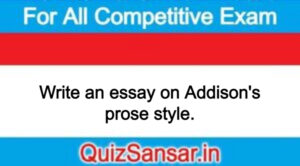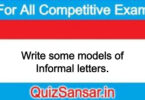
Write an essay on Addison’s prose style.
Write an essay on Addison’s prose style.
Ans.
Introduction: Addison has been most admired for the graces of his style which are doubtless the expression of his character. His love of moderation and reasonableness and his genuine good nature are reflected in the purity, regularity, clearness and felicity of his style. He is regarded as one of the masters of English prose and as one of the greatest prose stylists. What strikes us most about his style is clearness or lucidity, as well as naturalness. Addison does not strain after effects. There are no rhetorical flourishes in his prose, nothing pretentious or pompous, no affection. It is a straight style, without any obscurities of complexities or superfluities. These qualities in his style reflect the qualities of his character like sincerity, honesty, modesty, reserve and piety. His is not a laborious style, not an involved style. The following features of his prose style are being given below:
1. Clarity and Lucidity: The striking features of Addison’s style are clarity and lucidity. There is no ambiguity. There is no obscurity or complexity. There is no superfluity. He is not difficult to understand. Even a long sentence does not present any difficulty to the understanding of the readers.
2. Marked with Exactness: His prose is marked by exactness of expression. Nothing purposeless and superfluous is in it. Everything is systematically arranged and is in its right place. Each word is a brick supporting the arch of each sentence, and each sentence supporting the whole paragraph.
3. Compactness: Addison is equally capable of expressing himself in short and compact sentences. These sentences are neat and highly effective. In the essay. The Scope of Satire, we have the following sentence which exemplifies his ability to write in a short and neatly compact style:
“That vice and foily ought to be attacked wherever they could be met with, and especially when they were placed in high and conspicuous station of life.”
The following sentence from the essay, Fans, is equally effective in its brief and compact nature:
“Women are armed with fans as men with swords, and sometimes do more execution with them.”
4. The Use of Allusions and Quotations: Addison uses several allusions in the course of his essays. He uses them to illustrate, convince, add force to his argument, enhance the ironic and satiric effect. The variety of allusions is great. There are historical allusions. Biblical. literary, and mythological allusions. Quotations too are given from many sources. The essay Female Orators has references to Socrates, his teacher Aspasia. Hudibras, the hero of Samuel Butler’s satiric poem of the same name, a reference and quotation from the wife of Bath’s tale, a quotation from the ancient Latin poet, Ovid. In the same essay we have also an allusion to the French philosopher, Descartes. In the essay. On Witchcraft, we have a quotation from Thomas Otway.
5. The Use of Anecdotes: Addison uses anecdotes very successfully, mostly, of course to enhance the humour but he also uses them to illustrate and lend greater force to his point. Sometimes these anecdotes are taken from older literature or popular stories. Mostly we have imaginary anecdotes about imagery characters invented by Addison himself to suit the purposes of illustration of a point, or for satiric purposes. An imaginary incident is given in the essay. On Witchcraft, when Addison describes the visit to Moll White’s hovel. This kind of imaginary incidents and anecdotes give vividness and colour to his essays. He also uses the device of a letter from an imaginary correspondent sometimes.
6. The Use of Similes, Metaphors and Antitheses: Addison’s style is not highly figurative. There are no high-flown or fanciful similes and metaphors in his writings but he does use similes, metaphors, antitheses, etc. in his own homely and modest way, and very effective they are, too, in driving a point home to his readers. Nor does he work out his figures of speech in an elaborate or detailed manner:
“As the feist wines have often the taste of the soil, so even the most religious thoughts often draw something that is particular from the constitution of the mind in which they arise.”
(Uncharitable Judgement)
Addison mostly uses similes and metaphors for humorous effect and in this he is very successful. Note the humour of the statement that Whigs and Tories engage when they meet as naturally as the elephant and the rhinoceros. He often borrows simile from other writers as he does in Female Orators. He quotes Hudibras “The tongue is like a race horse, which runs the faster the lesser weight it carries.” In the essay, Fans, fans are compared to weapons in the hands of a soldier.
7. Irony, the Essence of Addison’s Humour : Humour is an important quality of Addison’s style. The essays like Valetudinarians and The Cries of London are excellent examples of Addison’s humour. His ironical and satirical observations on women in A Lady’s Library. French Fopperies, Fans, Ladies Head-Dresses and The Philosophy of Hoods are most delectable, but Female Orators is a masterpiece from this point of view. Addison attacks vice and folly, without trying to hurt the person or the individual. His essential humanity is seen in the nature of his irony which is directed against classes. groups or multitudes of persons and never against particular men or women. His anecdotes allusions, metaphors and similes are often used to contribute to humour and irony but humour and irony are never allowed to get out of control. They are there for a purpose namely for the purpose of instruction and reformation.
Choice of Words and Phrases: Addison is said to have been so fastidious in his composition that he would often stop the press to alter a preposition or conjunction. He is never slipshod of flaccid. He was an elegant craftsman who chiseled his sentences till they achieved the best possible finish. His style is marked by a free, unaffected movement, graceful transitions, delicate harmonies, an appropriateness of tone, an effortless mystery, a sense of quiet power, an absence of exaggeration or extravagance, a light and playful fancy. He obeyed the laws of literary art and his style was shaped and guided by a sense of literary beauty.
Thus, it can be observed that almost every critic has lavished praise on Addison for his style. Prof. Courthope remarks: “Addison may be said to have almost created and wholly perfected English prose as instrument for the expression of social thought.” Dr. Johnson remarks on Addison’s style: “Whosoever wishes to attain an English style, familiar, but not coarse and elegant but not ostentatious, must give days and nights to the volumes of Addison.”
-
Write the critical appreciation of the poem No. 12 entitled Far Below Flowed.
-
Write the critical appreciation of the poem No. 11 entitled Leave this Chanting.






